|
Having trouble reading this email?
Download the PDF.

Thematic focus: : Ecosystem management, Environmental governance, Climate change
Saving the Great Migrations: Declining wildebeest in East Africa?
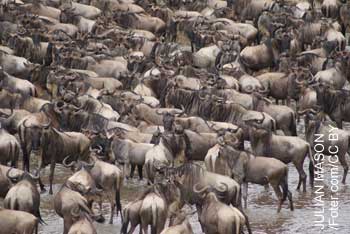
The iconic wildebeest migrations of East Africa are an important ecological phenomenon and massive tourist attraction.
However, many wildebeest populations are in drastic decline across the region (Estes and East, 2009). Their dispersal
areas and migratory corridors are being lost due to high human population densities, increasing urbanisation, expanding
agriculture and fences. Their loss would contribute to biodiversity decline, and jeopardise tourism and other ecosystem
services. Urgent efforts need to be made to protect wildebeest migratory corridors and dispersal areas to ensure these
great migrations for the future.
Why is this issue important?
Large scale animal migrations were once common around the world, but many have now collapsed, and others face serious decline
(Bolger et al., 2008; Harris et al., 2009). For example, on the Great Plains of North America, the American bison once numbered
as many as 30 million animals; today only few remnants remain due to over- hunting (Bolger et al., 2008). In Central Asia, the
Saiga antelope has declined from over 1 million animals in 1980 to less than 200,000 in 2000 (Milner-Gulland et al., 2001). In
Kenya, the migration of vast herds of zebra and Thomson’s gazelle between the Lake Nakuru-Elementaita region and the Lake Baringo
disappeared in the early part of the 20th century due to over-hunting, habitat loss and other human disturbances (Ogutu et al., 2012).
The East African savannas are well known for the large-scale seasonal migrations of grazing herbivores. Perhaps one of the most well-known
is the annual migration of 1.3 million wildebeest, 0.6 million zebras and Thomson’s gazelle in the Serengeti-Mara ecosystem (Sinclair, 1995).
The significance of this migration is huge: it is the largest and most species diverse large mammal migration in the world. It is of iconic
importance for tourism and has huge ecological significance, resulting in the Serengeti National Park in Tanzania being listed as a World
Heritage Site (UNESCO, 2013).
The East African savannas are highly variable ecosystems, so migration enables animals to track spatially and temporally varying resources
across the landscape. This gives migratory populations an advantage over resident populations, and allows these populations to rise to very
high abundances (Hopcraft et al., 2013). Migrants may also move to access breeding grounds, to reduce the risks of predation and disease,
and to enhance their genetic health (Bolger et al., 2008).
Wildebeest migrations are important both ecologically and economically. They play a vital role in ecosystem function and provide a
number of important ecosystem services. They also have a direct effect on predator populations and other wildlife species, and on
grass food resources (Sinclair et al., 2008). Economically, wildebeest migrations are important because they draw in tourism and
thus contribute significantly to national economies. Tourism generated an estimated US$1.2 billion revenue in Kenya in 2012 and
US$1.3 billion in Tanzania in 2011 (KNBS, 2013; RoT, 2011). In Tanzania, the northern safari circuit alone, the main attraction
of which is the Serengeti-Mara wildebeest migration, generated an estimated US$550 million in 2008 (Mitchell et al., 2009).
Any loss of wildlife migrations, or their habitats, could undermine some of East Africa’s key tourism products with significant
impacts on national economies.
What are the findings?
Declining wildebeest in East Africa
Wildebeest depend on migratory corridors and dispersal areas as they migrate out of protected areas to their seasonal habitats, often
located in pastoral lands. Migratory corridors and dispersal areas usually cross human-dominated landscapes where land use
practices are becoming increasingly incompatible with wildlife. As these areas are degraded or lost, severe declines in the
wildebeest populations can result.
In East Africa, the white-bearded wildebeest, found across Kenya and Tanzania as shown on Figure 1, is facing large declines due
to incompatible land uses in their migratory corridors and dispersal areas (Estes and East, 2009). This has occurred as their
migratory corridors and dispersal areas have become blocked or lost, limiting their migratory movements. The result has been the
near collapse of many wildebeest populations. The exception to this general pattern is the Serengeti-Mara population, which
increased six fold between 1963 and 1977 following the eradication of rinderpest, before stabilizing at its current population
of approximately 1.3 million (Hopcraft et al., 2013). In southern Africa, the blue wildebeest is stable or increasing; although
their numbers are still far lower than their 1960s levels (Estes and East, 2009).
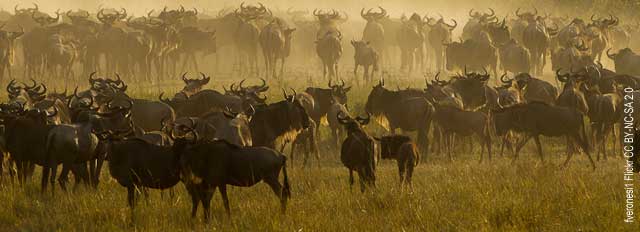
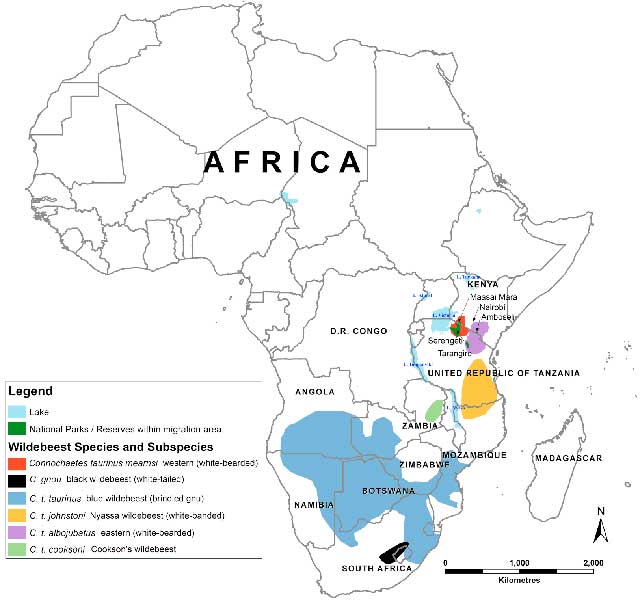
Figure 1: Map showing the distribution of wildebeest subspecies in Africa
including some important National Parks and Reserves in Kenya and Tanzania. Source: (Estes, 2006), visualisation by UNEP/DEWA.
Full Size Image
In Kenya, all four wildebeest populations are declining dramatically as indicated by the latest trends (Figure 2). In particular,
in the Mara ecosystem, found within Narok County, the wildebeest population that migrates annually between the Maasai Mara National
Reserve and the Loita Plains declined by more than two-thirds, from approximately 113,000 in 1977 to 35,000 by 2009 due to the
expansion of agriculture (Ogutu et al., 2011) and continues to decline to date. In the Athi-Kaputiei ecosystem, the wildebeest migration
between the Nairobi National Park and the adjoining Athi-Kaputiei Plains declined by more than 90%, from over 30,000 in 1978 to under
2,000 by 2011 as a result of increasing urbanisation, fencing, settlements, mining and other developments (Ogutu et al., 2013).
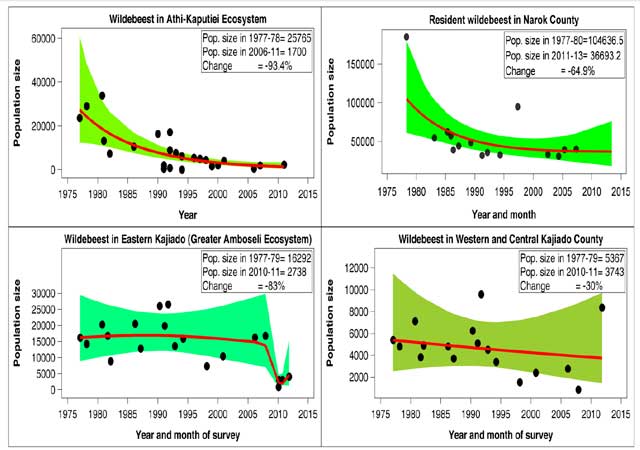
Figure 2: Trends in wildebeest populations in four regions of Kenya.
Black dots are population estimate from aerial surveys, the red lines are the fitted trend curves, and the shaded bands are the 95% confidence bands.
(Figure courtesy of Joseph O. Ogutu, data drawn from Ogutu et al., 2013; Ogutu et al., submitted).
Full Size Image
In Tanzania, in the Tarangire-Simanjiro ecosystem, the wildebeest migration from Tarangire National Park to the Simanjiro Plains
declined by 88%, from 43,000 in 1988 to 5,000 in 2001 due to expanding cultivation and settlements blocking their migratory corridors
(Bolger et al., 2008; Msoffe et al., 2011).
In each of these cases, wildebeest are prevented from accessing their wet season ranges due to the blockage of migratory corridors or the loss
of habitat in their dispersal areas. Wildebeest are especially vulnerable to human impacts in their wet season ranges. Many protected areas
in East Africa primarily conserve the dry season habitat for migratory wildlife, with the wet season ranges occurring almost entirely outside of
protected areas on adjacent communal or private lands (Fynn and Bonyongo, 2011). Protected areas also tend to be small and were not designed to
conserve all of a migratory species’ habitat requirements (Fynn and Bonyongo, 2011). As a result, wildebeest must journey outside of protected
areas to reach their wet season ranges. Here they face a number of pressures due to human population growth, land use change and increasing development.
In the past, protected areas were able to sustain large migratory wildebeest populations because human population densities were low enough
to allow them to migrate outside of protected areas to their wet season ranges. However, this is becoming increasingly difficult as human
populations surrounding protected areas rise, and land use changes and habitat loss intensify. Today, nearly all the world’s remaining
large wildlife populations exist in unfragmented migratory systems (Fynn and Bonyongo, 2011). For example, the Serengeti-Mara ecosystem
migration has been sustained because it has survived in a relatively intact ecosystem contained within a network of protected areas that
encompass all the grazing habitats required to support a large migratory population. However, this migration too now faces a
number of threats (see Box 1).
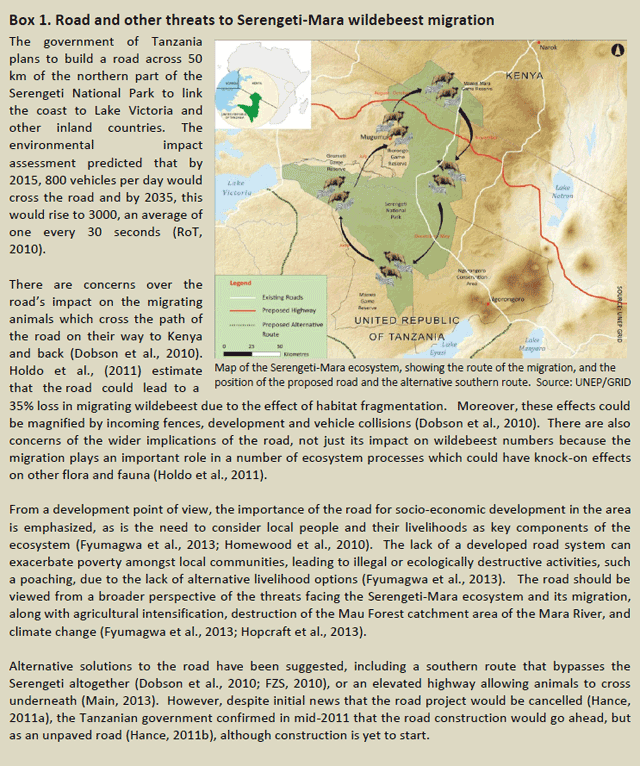
Threats to wildebeest migrations
The loss or fragmentation of habitats is one of the main threats to wildlife migrations globally (Bolger et al., 2008; Harris et al., 2009).
In East Africa, wildebeest migrations are in decline due to a number of land use activities causing habitat loss and fragmentation in their
wet season dispersal areas. These land use activities, which include cultivation, land subdivision, settlements, fencing and other
infrastructure, disrupt migratory movements and cause wildebeest populations to decline.

Fences obstruct migratory routes and have deleterious impacts on wildlife populations (Bolger et al., 2008; Harris et al., 2009).
Fences are used to stop resource competition and disease transmission between wildlife and livestock, to prevent poaching and to
protect crops and homes. Fencing is one of the main causes of the crash in the wildebeest population in the Athi-Kaputiei ecosystem
in Kenya, blocking and threatening migratory routes (Ogutu et al., 2013). More than 20% of the ecosystem is now fenced, and a number
of migratory corridors linking the Nairobi National Park and the Athi-Kaputiei Plains have been blocked by fences (MEMR, 2012) (Figure 3).
Now, only few wildebeest enter Nairobi National Park during the dry season (Ogutu et al., 2013). Similarly, fencing, cultivation and other
developments now threaten the wildebeest migrations in the Amboseli ecosystem and the Mara-Loita Plains (MEMR, 2012).
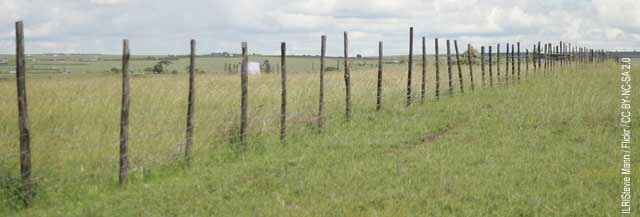
Roads obstruct migratory routes, cause wildlife mortality due to vehicle collisions, and decrease landscape connectivity
(Lesbarrčres and Fahrig, 2012). Due to increased access, roads can also open up new areas for development, leading to land
uses incompatible with wildlife. These are many of the concerns in the development of a new road through the Serengeti National
Park (see Box 1). In Kenya, a similar threat faces the wildebeest migration in the Athi-Kaputiei ecosystem due to the upgrading
of the Athi River-Namanga Road and the proposed Greater Southern Bypass Road along the southern boundary of Nairobi National Park (FoNNAP, 2011).
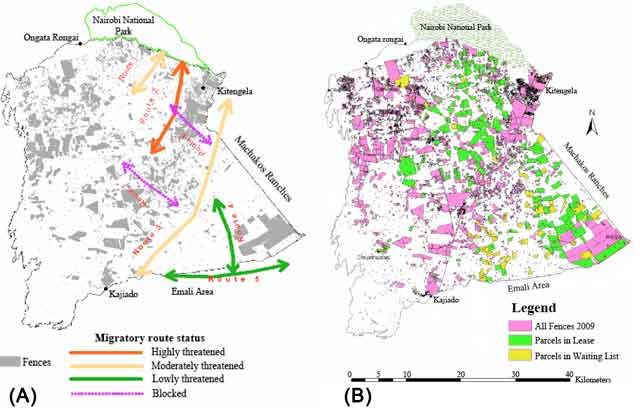
Figure 3: (A) Map showing the position of fences blocking
wildlife migratory routes to and from the Nairobi National Park of the Athi-Kaputiei ecosystem in Kenya, and (B) initially fenced land parcels now
signed up to the wildlife lease program prohibiting fencing (from MEMR, 2012).
Full Size Image
Poaching is a threat to many migratory populations, particularly as human populations around protected areas increase (Bolger et al., 2008;
Harris et al., 2009). In the Serengeti National Park it is estimated that local consumption of bushmeat is responsible for approximately
70,000-129,000 wildebeest deaths per year (Rentsch and Packer, 2012). A high intensity of poaching is also linked to a decline in wildlife
numbers in the Mara area of Kenya (Ogutu et al., 2009). Any further increase in the amount of poaching in the Serengeti-Mara ecosystem
could lead to declines in the wildebeest population (Hopcraft et al., 2013).
Climate change is a new and growing threat to wildlife migrations in the East African savannas. The increased frequency
and severity of droughts and floods that is expected to occur (IPCC, 2012) will modify vegetation growth and hence food
availability for the migrating animals. In the Amboseli ecosystem, a severe drought caused the wildebeest population to
crash by more than 85% in 2009 (MEMR, 2012). By 2010, the population numbered only 3,000 animals, down from over 15,000
animals before the drought, the lowest observed for more than 30 years (MEMR, 2012; Ogutu et al., submitted; Figure 2).
The ability of migrants to respond to changing climatic conditions is likely to be impaired by such man-made threats as habitat
loss and fragmentation. As migratory corridors and dispersal areas are lost due to land use change, this will curtail migratory
movements and compromise the ability of migrants to cope with the widening climatic variability expected as a consequence of
global warming (Owen-Smith and Ogutu, 2012). In the Athi-Kaputiei ecosystem, Ogutu et al. (2013) show how compounding of the
effects of human development with those of widened annual rainfall variation threatens wildlife populations.
What is being done?
Since most migrants wander outside of protected areas, it is crucial to include communities and landowners in
conservation efforts through participation in wildlife management and benefit-sharing. In the East African rangelands,
economic benefit to local communities from wildlife has been meagre (Homewood et al., 2009) with little incentive to
help protect migrants or their dispersal areas and migratory corridors.
Efforts are now being made to secure wildlife dispersal areas and migratory corridors through the use of community
conservancies, payments for ecosystem services and other economic incentives. For example, in the Mara, eight wildlife
conservancies have been formed, which offer land lease payments of US$25-40 per hectare (ha) per year to landowners
(Bedelian, 2012). These schemes, financed by ecotourism operators, aim to keep land open for wildlife and provide
landowners with a regular income stream. They now cover over 90,000 ha, securing vital migratory corridors and dispersal
areas for wildebeest from both the Serengeti and the Loita Plains (MEMR, 2012).
In the Athi-Kaputiei ecosystem, the wildlife conservation lease programme, supported by a number of donors, offers
participating landowners US$10 per hectare per year to keep their land open for wildlife and livestock in the
wildebeest dispersal area. This programme is being targeted to secure wildlife migratory corridors and critically
reduce fencing in this ecosystem and by 2012 covered 24,200 ha (Figure 3) (MEMR, 2012; Ogutu et al., 2013).
In another approach, environmental easements are being applied to protect privately owned land adjacent to
Nairobi National Park, including placing it under park management (Watson et al., 2010; USAID, 2013).
Also in this ecosystem, the community and other stakeholders have recently developed the first community driven
land use master plan to sustainably manage wildlife dispersal areas alongside livestock grazing, settlements
and other land uses in the ecosystem (Nkedianye et al., 2009). In the Tarangire-Simanjiro ecosystem in
Tanzania, payments for ecosystem services, financed by tour operators, are being used to protect the
dispersal area of migratory wildebeest and other wildlife in the Simanjiro plains (Nelson et al., 2010).
What are the implications for policy?
Conserving migratory routes requires implementing conservation plans beyond protected area boundaries. Dispersal areas and
migratory corridors can be kept open for wildlife, by encouraging wildlife-friendly land uses, and the cooperation and
participation of community and private landowners. Governments need to provide the correct enabling policy and legislative
environment to support the types of initiatives already emerging to protect migratory habitat. Due to the trans-boundary
nature of wildebeest migration in East Africa, the respective countries and governments need to work together to mitigate
threats to the migrations.
Good scientific information on where, when and why wildlife migrations occur is needed to inform conservation
and management decisions. This includes mapping the movements and ranges of wildebeest, the ecological drivers
of migration, population levels, and a good understanding of the threats to migrants and their habitats. The Kenya
and Tanzania governments are already mapping wildlife corridors and migratory routes with the aim of securing
critical wildlife areas (Jones et al., 2009; MEMR, 2012; TAWIRI and WCS, 2013). In other initiatives, researchers
are collaring wildebeest to track their movements to understand how landscape fragmentation and climate change are
affecting wildebeest, and reporting their movements online (CSU, 2013).
Conserving migrations requires a proactive approach, anticipating and responding to threats before the abundance
of migrating animals is critically reduced, and thus the phenomenon of migration long gone (Harris et al., 2009;
Wilcove and Wikelski, 2008). In this regard, conservation organisations such as the Convention of Migratory Species,
which works to conserve migrations of species threatened with extinction, could be expanded to conserve threatened
or endangered migrations, and not just those which contain rare or endangered species (Harris et al., 2009).
Efforts to secure dispersal areas and migratory corridors will require an integrated approach to land use
planning both inside and outside of protected areas. By taking into account wildlife and their migratory
routes, people, livestock, landscapes and natural resources, a more comprehensive conservation effort can be made.
Thus, there is a need to work collaboratively with landowners and users to identify threats along migratory
routes so these critical areas can be effectively protected. Extensive consultation with communities and landowners,
as well as governments, conservation organisations and other stakeholders, must be a prerequisite to any action.
The rapid and dramatic wildebeest population declines in East Africa calls for urgent, comprehensive and
decisive remedial steps to protect the remaining populations and rehabilitate their habitats. This will
enhance their resilience to the intensifying droughts and contribute to the sustainability of local livelihoods.
Acknowledgement
Writer: Claire Bedeliana
Production and Outreach Team: Arshia Chanderb, Erick Litswac, Kim Gieseb,
Lindsey Harrimanb, Michelle Anthonyb, Reza Hussainb, Tejaswi Girib, Theuri Mwangic and Zinta Zommersc
Special thanks to Lindsey Harrimanb, Peter Gilruthc, Frank Turyatungac, Anna Stabrawac, Theuri Mwangic,
Zinta Zommersc, Joseph Ogutud, Zeke Davidsone, Michael Hoffmannf
for their valuable comments, input and review, and Shelley Robertsong for copy editing
(a University College, London, b UNEP/DEWA/GRID-Sioux Falls, c UNEP/DEWA-Nairobi, d University of Hohenheim,
e Conservation Biologist, Kenya, f UNEP-WCMC, g Munk School of Global Affairs, University of Toronto)
References
Bedelian, C., 2012. Conservation and ecotourism on privatized land in the Mara, Kenya: The case of conservancy land leases. Land Deal Politics Initiative Working Paper 9.
Bolger, D., Newmark, W., Morrison, T., Doak, D., 2008. The need for integrative approaches to understand and conserve migratory ungulates. Ecology Letters 11(1), 63-77.
CSU, 2013. Gnu Landscapes. NREL Colorado State University. http://www.nrel.colostate.edu/projects/gnu (accessed 26.11.13).
Dobson, A., Borner, M., Sinclair, A., Hudson, P.J., Wolanski, E., 2010. Road will ruin Serengeti. Nature 467(7313), 272–273.
Estes, R.D., 2006. Wildebeests of the Serengeti. Natural History Magazine. September. 28 – 35.
Estes, R., East, R., 2009. Status of the wildebeest (Connochaetes taurinus) in the wild 1969-2005.
Wildlife Conservation Society Working Paper No. 37.
Fynn, R., Bonyongo, M., 2011. Functional conservation areas and the future of Africa’s wildlife. African Journal of Ecology 49(2), 175-188.
Fyumagwa, R., Gereta, E., Hassan, S., Kideghesho, J., Rřskaft, E., 2013. Road as a Threat to the Serengeti Ecosystem. Conservation Biology 27(5), 1122-1125.
FoNNAP, 2011. How the proposed greater southern bypass will affect Nairobi Park. Friends of Nairobi National Park.
http://fonnap.wordpress.com/2011/08/23/how-the-proposed-greater-southern-bypass-will-affect-nairobi-park/
(accessed 26.11.13).
FZS, 2010. The Serengeti North Road Project. Frankfurt Zoological Society.
http://www.zgf.de/download/1135/SerengetiRoad_Presentation2.pdf (accessed 26.11.13).
Hance, J., 2011a. Serengeti road cancelled. Mongabay. 23 June 2011.
http://news.mongabay.com/2011/0623-hance_serengeti_road.html (accessed 26.11.13).
Hance, J., 2011b. Unpaved road through Serengeti to progress. Mongabay. 2 July 2011.
http://news.mongabay.com/2011/0702-hance_serengeti_road.html (accessed 26.11.13).
Harris, G., Thirgood, S., Hopcraft, J., Cromsigt, J., Berger, J., 2009. Global decline in aggregated migrations of large terrestrial mammals. Endangered Species Research 7(1), 55-76.
Holdo, R., Fryxell, J., Sinclair, A., Dobson, A., Holt, R., 2011. Predicted impact of barriers to migration on the Serengeti wildebeest population. PloS one 6(1), e16370.
Homewood, K., Brockington, D., Sullivan, S., 2010. Alternative view of Serengeti road. Nature 467(7317), 788–789.
Homewood K., Kristjanson, P., Chevenix Trench, P., 2009. Staying Maasai? Livelihoods, conservation and development in East African Rangelands. Springer, New York.
Hopcraft, J., Sinclair, A., Holdo, R., Mwangomo, E., Mduma, S., Thirgood, S., Borner, M., Fryxell, J., Olff, H., 2013. Why are wildebeest
the most abundant herbivore in the Serengeti ecosystem? Serengeti IV: Sustaining Biodiversity in a Coupled Human–Natural System, University of Chicago Press, Chicago.
IPCC, 2012. Managing the Risks of Extreme Events and Disasters to Advance Climate Change Adaptation. A Special Report of Working Groups I and II of
the Intergovernmental Panel on Climate Change. Cambridge University Press, Cambridge, UK, and New York, NY, USA.
Jones, T., Caro, T., Davenport, T., 2009. Wildlife Corridors in Tanzania. Unpublished report. Tanzania Wildlife Research Institute (TAWIRI), Arusha.
KNBS, 2013. Economic survey 2013 highlights. Ministry of Devolution and Planning. Kenya National Bureau of Statistics.
http://www.knbs.or.ke/Economic%20Surveys/Cabinet_Secretary_Presentation_on_Economic_Survey_May_2013.pdf (accessed 26.11.13).
Lesbarrčres, D. and Fahrig, L., 2012. Measures to reduce population fragmentation by roads: what has worked and how do we know? Trends in ecology & evolution 27(7), 374-380.
Main, D., 2013. ‘Serengeti Highway Compromise Proposed by Famed Scientist.’ Live Science, 15th May 2013.
http://www.livescience.com/32046-leakey-elevated-serengeti-highway.html (accessed 26.11.13).
MEMR, 2012. Mapping Wildlife Dispersal Areas and Migratory Routes/Corridor (Part I): Southern Kenya Rangelands (Draft Version March 2012). Ministry of Environment and Mineral Resources (MEMR). Nairobi, Kenya.
Milner-Gulland, E., Kholodova, M.V., Bekenov, A., Bukreeva, O., Grachev, I., Amgalan, L., Lushchekina, A., 2001. Dramatic declines in saiga antelope populations. Oryx 35(4), 340–345.
Mitchell, J., Keane, J., Laidlaw, J., 2009. Making success work for the poor: Package tourism in Northern Tanzania. ODI/SNV.
Msoffe, F., Kifugo, S., Said, M., Neselle, M., Van Gardingen, P., Reid, R., Ogutu, J., Herrero, M., de Leeuw, J., 2011. Drivers and impacts of land-use change in the Maasai
Steppe of northern Tanzania: an ecological, social and political analysis. Journal of Land Use Science 6(4), 261-281.
Nelson, F., Foley, C., Foley, L., Leposo, A., Williams, A., 2010. Payments for Ecosystem Services as a Framework for Community‐Based Conservation in Northern Tanzania. Conservation Biology 24(1), 78-85.
Nkedianye, D., Radeny, M., Kristjanson, P., Herrero, M., 2009. Assessing returns to land and changing livelihood strategies in
Kitengela, in: Homewood, K., Kristjanson, P., Chevenix Trench, P. (Eds), Staying Maasai? Livelihoods, conservation and development in East African Rangelands. Springer, New York, pp. 115-149.
Ogutu, J., Owen-Smith, N., Piepho, H-P., Kuloba, B., Edebe, J., 2012. Dynamics of ungulates in relation to climatic and land use changes in an insularized African savanna ecosystem. Biodiversity Conservation 21; 1033-1053.
Ogutu, J., Owen‐Smith, N., Piepho, H., Said, M., 2011. Continuing wildlife population declines and range contraction in the Mara region of Kenya during 1977–2009. Journal of Zoology, 285(2), 99-109.
Ogutu, J., Owen-Smith, N., Piepho, H., Said, M., Kifugo, S., Reid, R., Gichohi, H., Kahumbu, P., Andanje, S., 2013. Changing
Wildlife Populations in Nairobi National Park and Adjoining Athi-Kaputiei Plains: Collapse of the Migratory Wildebeest. Open Conservation Biology Journal, 7, 11-26.
Ogutu, J., Piepho, H., Dublin, H., Bhola, N., Reid, R., 2009. Dynamics of Mara-Serengeti ungulates in relation to land use changes. Journal of Zoology 278, 1-14.
Ogutu, J., Piepho, H., Said, M., Kifugo, S., submitted for publication. Herbivore dynamics and range contraction in Kajiado: Climate change and land use changes,
population pressures, governance, policy and human-wildlife conflicts. Submitted and under consideration for publication in Open Conservation Biology Journal.
Owen-Smith, N., Ogutu, J., 2012. Changing Rainfall and Obstructed Movements: Impact on African Ungulates. Wildlife Conservation in a Changing Climate, 153.
Rentsch, D., Packer, C., 2012. Bushmeat Consumption and Local Demand for Wildlife: Wildebeest Offtake Estimates for Western Serengeti (mimeo).
RoT, 2010. Environmental and Social Impact Assessment for upgrading of Natta-Mugumu-Loliondo Road, Draft Report, October 2010. Submitted to The National Environmental Management Council, Dar es Salaam,
Tanzania.
http://www.savetheserengeti.org/issues/highway/tanzanian-governments-evironmental-impact-assessment/ (accessed 26/11/13).
RoT, 2011. The economic survey 2011. President’s Office, Planning Commission, Dar es Salaam. Republic of Tanzania.
http://www.mof.go.tz/mofdocs/Micro/Economic%20Survey%202011.pdf (accessed 26.11.13).
Sinclair, A., 1995. Serengeti past and present, in: Sinclair, A.R.E, Arcese, P. (Eds.), Serengeti II, dynamics, management and conservation of an ecosystem. University of Chicago Press, Chicago.
Sinclair, A.R.E., Hopcraft, J.G., Olff, H., Mduma, S.A.R., Galvin, K.A., Sharam, G.J., 2008. Historical and future changes to
the Serengeti ecosystem, in: Sinclair, A.R.E., Packer, C., Mduma, S.A.R., Fryxell, J.M. (Eds.), Serengeti III: Human impacts on ecosystem dynamics. University of Chicago Press, Chicago.
TAWIRI and WCS, 2013. Tanzania Wildlife Corridors. Tanzania Wildlife Research Institute and Wildlife Conservation Society.
http://www.tzwildlifecorridors.org (accessed 26.11.13).
UNESCO, 2013. Serengeti National Park. World Heritage List. United Nations Educational, Scientific and Cultural Organization (UNESCO).
http://whc.unesco.org/en/list/156 (accessed 26.11.13).
USAID, 2013. Kitengela Wildlife Conservation Project. United States Agency for International Development (USAID) Kenya.
http://www.usaid.gov/sites/default/files/documents/1860/Kenya%20Wildlife%20Conservation%20FACT%20SHEET_May2013.pdf (accessed 26.11.13).
Watson, R., Fitzgerald, K., Gitahi, N., 2010. Expanding options for habitat conservation outside protected areas in Kenya: The use of environmental easements. African Wildlife Foundation. Technical Papers No. 2.
Wilcove, D., Wikelski, M., 2008. Going, going, gone: is animal migration disappearing. PLoS biology 6(7), e188.
If you no longer wish to receive this bulletin you can unsubscribe anytime.
Information is regularly scanned, screened, filtered, carefully edited, and published for educational purposes. UNEP does not accept any liability
or responsibility for the accuracy, completeness, or any other quality of information and data published or linked to the site. Please read our
privacy policy and
disclaimer for further information.
|













